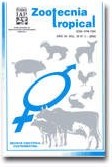
|
Zootecnia Tropical
Instituto Nacional de Investigaciones Agrícolas Venezuela
ISSN: 0798-7269
Vol. 28, No. 1, 2010, pp. 73-82
|
 Bioline Code: zt10010
Bioline Code: zt10010
Full paper language: English
Document type: Research Article
Document available free of charge
|
|
|
Zootecnia Tropical, Vol. 28, No. 1, 2010, pp. 73-82
| en |
Genetic diversity of Brycon orbignyanus  in the semi-natural reproductive system, using the RAPD marker in the semi-natural reproductive system, using the RAPD marker
Barrero, Nelson Mauricio Lopera; Ribeiro, Ricardo Pereira; Povh, Jayme Aparecido; Vargas, Lauro; Fornari, Darci Carlos; Sirol, Rodolfo Nardez & Rodríguez, María del Pilar Rodríguez
Abstract
The stock enhancement programs are being used more frequently as methods of fish conservation. However,
the genetic monitoring and the reproductive procedures evaluation are necessary to achieve viable and reliable
results. The purpose of this study was to analyze the genetic diversity of Brycon orbignyanus

used in stock
enhancement programs, in the semi-natural reproductive system, with the RAPD marker. Fifteen broodstocks (10
male and 5 female) and 95 larvae of the offspring were analyzed. The semi-natural reproductive system allowed the obtaining of a low mortality of the broodstocks using in the mating and all presented spawing/spermiation.
The nine primers used yielded 90 fragments, of which 73,33% were polymorphic. Differences (P <0,05) in the
frequency of 17 fragments were observed, without the presence of exclusive fragments. The Shannon genetic
diversity index and percentage of polymorphic fragments were lower in the offspring individuals. Genetic
similarity was higher in the offspring. The analysis of molecular variance results showed that the major part of
the genetic variation is within the groups (81,49%) and not between them (18,51%). The identity and genetic
distance among the groups were 0,953 and 0,049; respectively. In spite of the semi-natural reproductive system
to allow the decrease of mortality and an appropriate reproductive broodstocks behavior, was decrease of the
genetic variability in the offspring for the effect of the small number of broodstocks used during the reproduction
and for the low existent genetic variability among them.
Keywords
Brazil, fish, genetic conservation, genetic variability, RAPD-PCR, stock enhancement programs.
|
| |
| es |
Diversidad genética de Brycon orbignyanus  en el sistema reproductivo semi-natural, utilizando el marcador RAPD en el sistema reproductivo semi-natural, utilizando el marcador RAPD
Barrero, Nelson Mauricio Lopera; Ribeiro, Ricardo Pereira; Povh, Jayme Aparecido; Vargas, Lauro; Fornari, Darci Carlos; Sirol, Rodolfo Nardez & Rodríguez, María del Pilar Rodríguez
Resumen
Los programas de repoblamiento de ríos vienen siendo usados con mayor frecuencia como métodos de conservación
de la ictiofauna. Sin embargo, el monitoreo genético y evaluación de procedimientos reproductivos son necesarios
para obtener resultados viables en los ecosistemas impactados negativamente por el hombre. El objetivo de este
estudio fue analizar la diversidad genética de Brycon orbignyanus

utilizado en programas de repoblamiento, en el
sistema reproductivo semi-natural (SRSN), con el marcador RAPD. Fueron analizados 15 reproductores (Rp;10
machos y 5 hembras) y 95 larvas de la progenie. El SRSN permitió la obtención de una baja mortalidad de los Rp
utilizados en el cruzamiento y todos presentaron desova/espermiación. Los 9 iniciadores utilizados produjeron 90
fragmentos (fg), de los cuales 73,33% fueron polimórficos. Encontrándose diferencias (P <0,05) en la frecuencia
de 17 fg, sin la presencia de fg exclusivos. El índice de diversidad genética de Shannon y porcentaje de fg
polimórficos fueron inferiores en los individuos de la progenie. La similaridad genética fue mayor en la progenie.
El análisis de variancia molecular mostró que la mayor parte de la variación está dentro de cada lote (81,49%) y
no entre los lotes (18,51%). La identidad y distancia genética fue 0,953 y 0,049, respectivamente. A pesar que el
SRSN permitió la obtención de una baja mortalidad y adecuado comportamiento reproductivo de los Rp, hubo
disminución de la variabilidad genética en la progenie por el efecto del bajo número de Rp utilizados durante la
reproducción y por la baja variabilidad genética existente entre ellos.
Palabras-clave
Brasil, conservación genética, peces, programas de repoblamiento, RAPD-PCR, variabilidad genética.
|
| |
© Copyright 2010 - Zootecnia Tropical
Alternative site location: http://www.sian.inia.gob.ve/repositorio/revistas_ci/ZootecniaTropical/ztindice.htm
|
|
